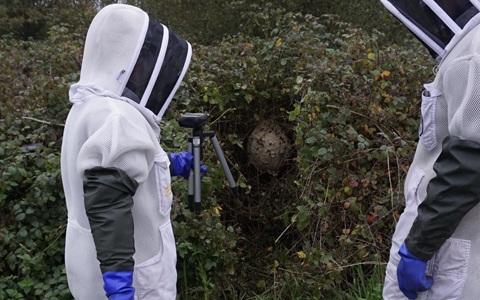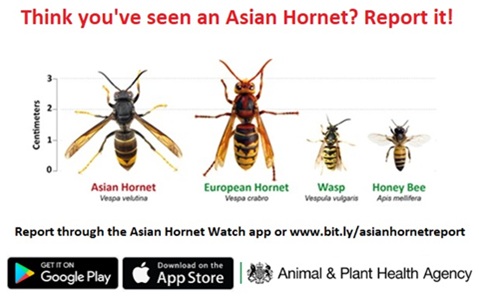
The frequency and volume of the sound from the nests of yellow-legged hornets - or Asian hornets - has been established for the first time by researchers at the University of Southampton.
It paves the way to faster detection and removal of the nests of the invasive species, which is experiencing a surge in numbers this year.
The National Bee Unit is reporting 73 Asian hornet sightings and 28 nests in 2025 to date - more than double the 28 recorded sightings in the same period last year.
Scientists at Southampton have established the fundamental frequency of Asian hornet nests to be 125 Hertz (Hz) and the loudness in the region of 51 Decibels (dB), which is comparable to a normal conversation.
This means that Asian hornet nests, which peak in numbers during September and October, can be detected and their sound used to distinguish them from the nests and hives of other wasps and bees.
The project was led by Paul White, Professor of Statistical Signal Processing at the University of Southampton, and project advisor Adrian Dwyer, with research undertaken by Acoustic Engineering graduate Sophie Gray.

Sophie said: "We observed and measured two Asian hornet nests and a European hornet nest in Jersey before they were destroyed. We found that the fundamental frequency is 125 Hz, and that the nest can be detected from about 20 metres away with a directional microphone.
"We also recorded European hornets and honeybees to determine if we can differentiate the frequency. The fundamental frequency of the European hornet is about 110 Hz, and honeybees about 210 Hz. It was great news to discover that the frequency is unique for each species, so they are distinguishable."
Asian hornets originate from Southeast Asia and pose a threat to native biodiversity in the UK - especially honeybees.
Sophie said: "The main issue with Asian hornets is that they are omnivorous and feed on a wide range of pollinators to feed protein to their young, especially honeybees. One nest of Asian hornets can destroy an entire beehive in two to three days."

Asian hornets measure 1-1.5 inches long and are black with an orange stripe on the fourth segment of the abdomen, with legs that look like they have been dipped in yellow paint.
They are not yet established in the UK, and all discovered nests - which can measure up to 80cm in diameter - are destroyed. Last year, 24 nests were destroyed predominantly in the South, and 260 in Jersey where they are prevalent.
"Asian hornet nests can be difficult to find because there is no typical place where they build them," explained Sophie. "They can be underground, or 50 feet up a tree, or in a bird box, or a bush - they can be anywhere.
"It typically takes two to three days to find the nest once a sighting of an Asian hornet is reported - and in that time the hornets can have completely killed a beehive of upwards of 20,000 bees."

In the UK and Europe, Asian hornets are active between April and November, peaking in September and October.
Sophie added: "Asian hornets first entered Europe in France in 2004, most likely in a shipping container. They spread like wildfire and are now established in France as well as across Southern Europe. They first came to England through Kent in 2016 and in the last two to three years have begun to establish themselves here."
Sophie is hoping to start a PhD at the University of Southampton in September, building on her research. She said: "The next step is to build a drone that can locate nests and significantly speed up how long it takes to find them."
If you spot an Asian hornet, you should report it to the UK Centre for Ecology and Hydrology . Information on how to identify Asian hornets is on The British Beekeepers' Association's website .






